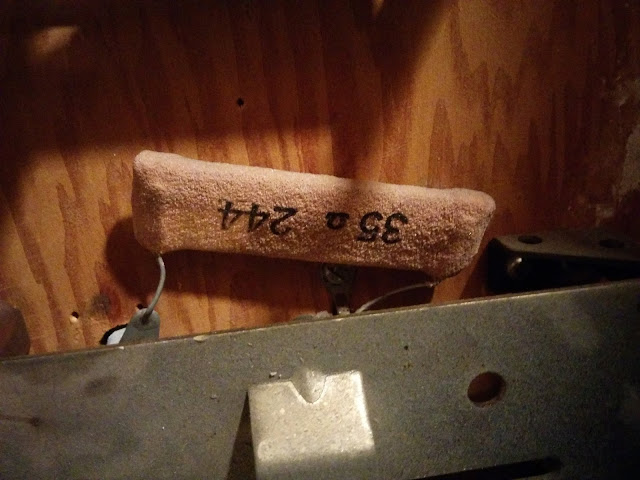Check this start /"Replay" switch at the front of the machine.
 |
| ummmmmmm |
The front plate? metal.
Start button? metal.
Switch stack? metal plates.
Activated by? Metal button pressing switches.
Switch voltage? 120V line voltage.
WHAT THE HELL COULD GO WRONG???
There was some worn fish paper and a piece of dried electrical tape. What the hell kind of design was this? Next time you complain about your electrician bill, please remember that safety codes are updated for very good reasons.
I wanted to play around with it a bit so I went out and asked the pinball community for an isolation transformer.
These are common in Ontario as, probably due to machines like we have here, were mandated by Ontario Hydro. In a home environ with everything gone over, not really needed, but for the older games they were a great idea.
I even pulled one of these out of a Baywatch way back when. For newer machines, they are still somewhat useful if one machine has a ground issues and someone touches lockdown bars on two machines in a row.
But everyone pulls them out because even if the game is off, they still draw a bit.
A quick aside, that thread I linked above had lots of gem information, including details about the bounce switch we had pondered in this machine. A message I sent a friend:
Yeah, so that's a thing.
I so want a 1960s video of an operator going down the rows KICKING each of his machines to "turn it off".
WHY THE HELL WERE ON/OFF SWITCHES AN OBSCURE CONCEPT?
But here it is, in all of it's glory. The circular metal bar in the center of that round plastic goes all the way down to the bottom of the cabinet so that yes, it can bounce if kicked. If that circuit is opened, the voltage to the transformer temporarily disappears, the hold relay has lost power and disengages, turning off the GI and all power on the other wise of the transformer.
I got an isolation transformer from another collector in under 24 hours. rescuing it from the recycler:
 |
| this thing is over 10 pounds. You could develop a workout regime around it. |
I put 5 layers of electrical tape in a stack and used that to buffer the start button. Even with the isolation transformer and fresh tape barrier, I still pressed that start button with a plastic funnel.
I couldn't do it otherwise.
The game started chunking forward, but I went around back and noticed a whiff of smoke. OMG NO!
Unplugged it right away.
I took a look at the rear stepper unit and behind it was this badass oldschool resistor. But neither it nor the stepper solenoid were warm.
 |
| this might as well be a prop on The Flintstones |
Next day:
Upon getting the machine, I had previously swapped out 2 x 20A fuses with 2 10A ones. the main line fuse was 15A, but should have been 5A, so put that one in.
I raised the playfield and turned it on so I could better identify where the issue was, but aside from buzzing on the continuous solenoid relays, I couldn't find anything noticeable. No smoke.
I remain paranoid.
So instead of going further, I wanted to at least do something productive and clean the player stepper unit.
 |
| You can see the grime on all of the rivets and their paths |
 |
| first look with the outer plate removed, only a bit of sanding done in the upper left. Note how dirty the points are. |
 |
| cleaned and reassembled. |
I just want my game to look like something other than this:



No comments:
Post a Comment